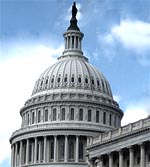
ABOVE: Gen. James Jones
Yesterday’s post mentioned a speech given by National Security Advisor General James Jones to the Senate Aerospace Caucus. I’ve now had a chance to look at a text of his speech as prepared and noticed at least one part that may be of considerable interest to exporters.
General Jones begins his speech with, and mentions throughout, some significant changes that have occurred since our current export control regime was initially instituted. Most striking was his observation that when we first started controlling exports troops were moved around on trains and that, notwithstanding that military trains have gone the way of camels, horses and elephants as a mode of troop transport, “military railway trains” are still mentioned in USML Category VII.
More significantly, General Jones mentions this difference:
“Specifically designed for military use†– a term still used in our munitions controls today – meant what it says: items were intended only for military use having little or no civilian use.
My frisson of delight at that phrase — “‘specifically designed for military use’ meant what it says” — was probably counterbalanced by the grinch-like scowls it would have provoked at the Defense Technology Security Administration (“DTSA”).
The folks at DTSA have been the chief proponents at the Department of Defense for the notion that the phrase doesn’t mean what it says, that it instead means that an item, regardless of why it was designed, could be used for military purposes. DTSA has continued to champion that interpretation of “specifically designed” during the classification process even though it is so broad that virtually everything — from the flat panel TV in your living room to the toilet plunger in your bathroom — could be used for military purposes and therefore are properly classified as USML items.
Supplications to the deity of your choice that “specifically designed” is returned to its original meaning as part of the current export reform efforts would not be out of place.

 Posted by
Posted by  Category:
Category: 

 Online journal DOD Buzz has some
Online journal DOD Buzz has some  An
An  The speech given this morning by Secretary of Defense Robert Gates to a business group detailing the administration’s plan for export reform is now posted on the Department of Defense website and can be found
The speech given this morning by Secretary of Defense Robert Gates to a business group detailing the administration’s plan for export reform is now posted on the Department of Defense website and can be found 

